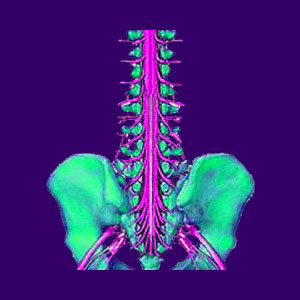
Lumbar spinal stenosis is the most common location for central canal narrowing conditions to develop. Spinal stenosis is a diagnosis that is the source of much debate in the medical community. Some healthcare practitioners view it as a primary source of acute and chronic back pain, while others see it as a normal and mostly asymptomatic part of the aging process.
Millions of patients are diagnosed with stenosis-related pain every year, although some are actually suffering from symptoms brought about due to a completely different causation. Medical opinion aside, the facts speak volumes. Research clearly shows no correlation between minor cases of stenotic change and the incidence of low back pain or sciatica. This same research tells that mild to moderate stenosis is to be expected in the lumbar regions of virtually every adult past middle age. However, severe stenotic alteration is known to be a primary cause of pain and a variety of disabling neurological expressions when the cauda equina is compressed definitively by an unyielding structural pathology.
This dissertation investigates why lumbar stenosis is one of the most misunderstood of the age-related spinal degenerative processes.
Lumbar Spinal Stenosis Facts
The lumbar spine is the area also known as the lower back. Stenosis is a condition which describes a narrowing of the central spinal canal. The spinal canal is the hollow passageway that contains the spinal cord and nerves. This canal is surrounded by the spine which offers structure and protection for the delicate neurological tissues.
Spinal stenosis is common for people to experience as they get older. Most elderly patients will demonstrate evidence of stenosis on an MRI or CT scan, yet have no pain or symptoms as a result of the condition. Occasionally patients will suffer spinal nerve compression from stenosis and in these circumstances, pain and neurological dysfunction in the lower body may result.
Lumbar Stenosis Symptoms
Mild and moderate cases of stenosis are usually pain-free conditions. Some patients experience discomfort in the lower back and often radiating into the legs and/or feet. Additional symptoms might include numbness, tingling or weakness in the back, buttocks, legs or feet.
Severe stenosis is a one of the usual causes of sciatica symptoms. This lower body radicular pain syndrome is a logical result when the nerve roots which form the sciatic nerve are functionally impaired due to structural compression.
Lumbar stenosis patients will often experience more pain when standing or walking. In the worst instances, the patient may not physically be able to do either for very long. The pain is often lessened from sitting or in certain reclined positions. This is one stenosis-specific expression that often differs from many other back pain conditions in the lumbar spine.
Lumbar Spinal Stenosis Suffering
We have seen patients suffering for years due to a misdiagnosed case of stenosis back pain. After years of unsuccessful treatments, and sometimes a failed stenosis surgery, the misery persists. These patients have symptoms which are blamed on this common scapegoat condition, but turn out to be from another physical or psychological cause. Remember, stenosis in the lower lumbar and lumbosacral areas is so incredibly commonplace and most patients have mild and completely asymptomatic versions of lower back canal narrowing.
Some patients do develop horrible pain and disability from spinal stenosis. These conditions are rare, but can be very serious and may require invasive treatment. In these cases, surgery is sometimes the best option and can often provide an acceptable result, depending on the underlying source of the stenotic change. However, make sure that you have exhausted all conservative therapies before undergoing any surgical treatment for your spinal stenosis. Also, be 100% sure of the validity of your diagnosis before even thinking seriously about an operation. It would be a shame to endure all that trauma just to have a continued expression of pain post-surgery. Unfortunately, this happens all the time.





